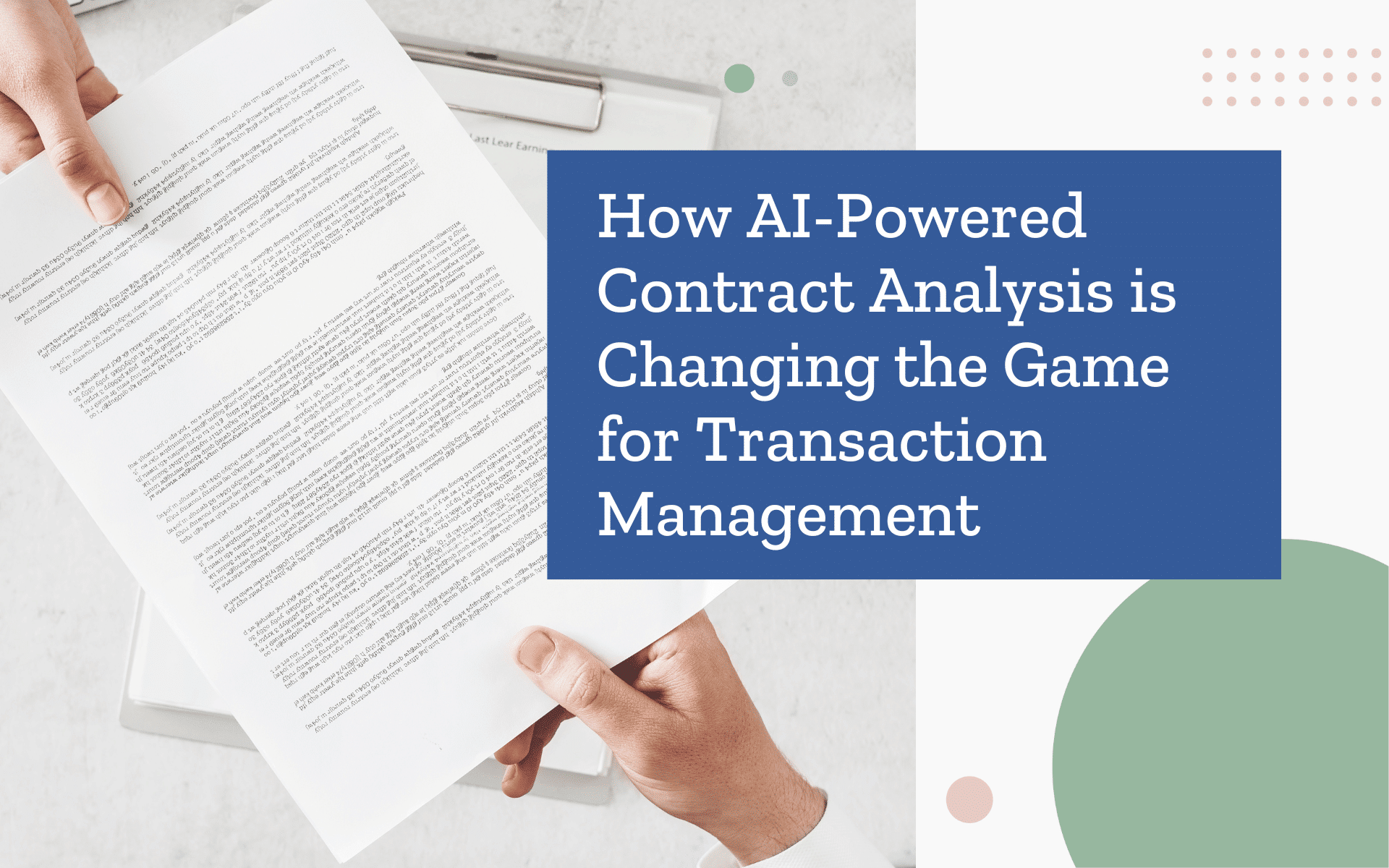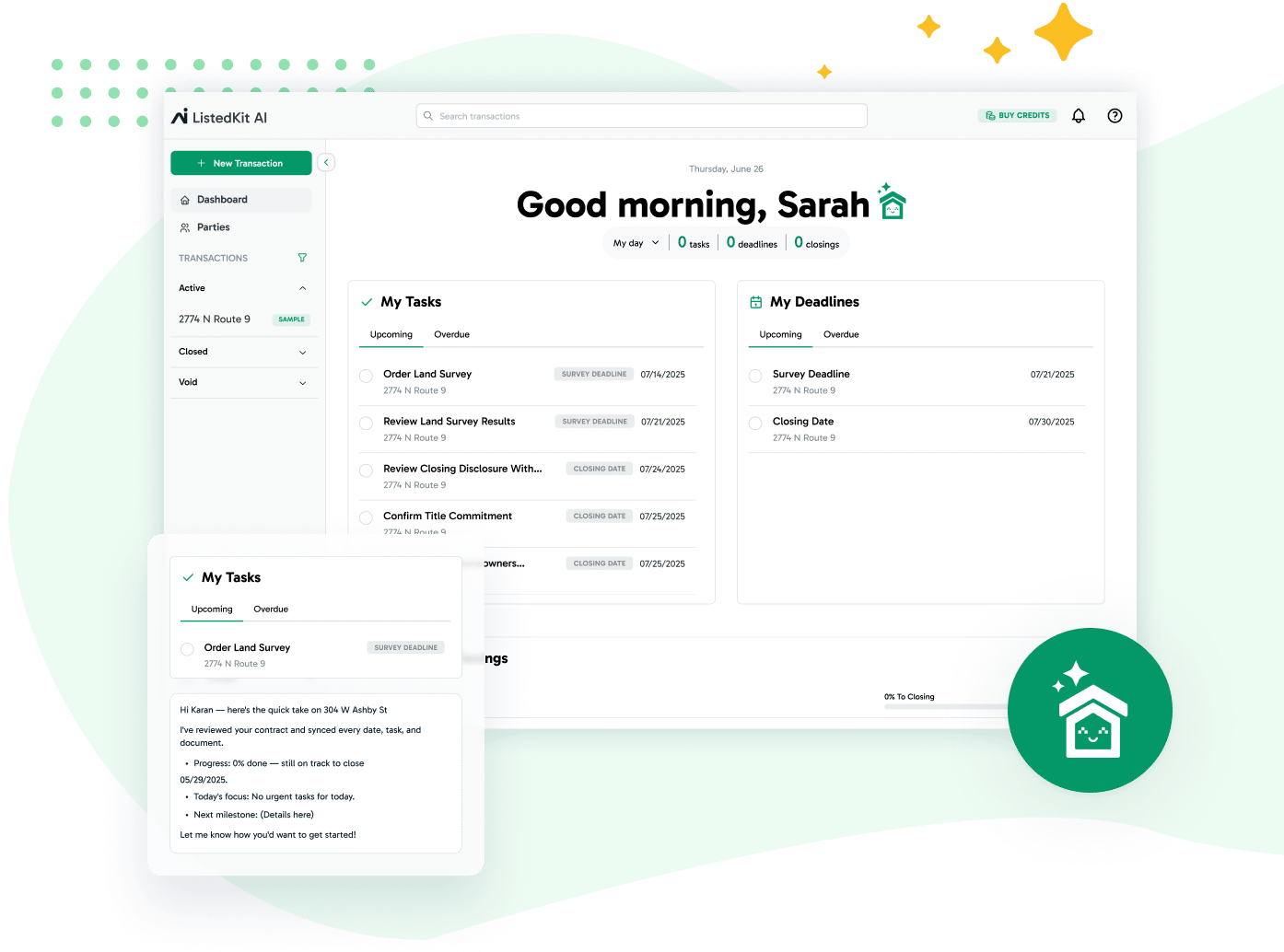Transaction coordinators face mounting pressure with complex, time-sensitive contracts. The intricate details in legal documents often lead to missed deadlines, errors, or compliance failures, derailing deals.
AI contract analysis offers a better way forward. By automating the review process, AI identifies key clauses, tracks deadlines, and checks compliance, empowering coordinators to focus on delivering exceptional client experiences.
In this article, we’ll explore the drawbacks of manual reviews, how AI simplifies contract management, and how tools like ListedKit seamlessly integrate these advanced capabilities.
The Challenges of Manual Contract Review
Manual contract reviews are a cornerstone of transaction coordination, yet they remain time-consuming with potential risks.
- Vast Amounts of Data to Process. Real estate transactions often require reviewing legal documents packed with key terms, complex clauses, and deadlines. This sheer volume overwhelms coordinators, particularly when managing multiple contracts simultaneously. Human intervention often leads to slower outcomes and higher error rates without tools to simplify these processes.
- Risk Assessment in Manual Reviews. Missing a key clause, such as a termination contingency, can have significant implications. For instance, an oversight in contract enforceability could lead to disputes that prolong closing timelines or increase legal costs. Manual review limits the ability to conduct thorough compliance checks, leaving stakeholders vulnerable to legal and financial risks.
- The Strain on Operational Efficiency. The repetitive nature of contract management tasks—like identifying contractual terms, extracting insights from contract data, and verifying compliance—takes time away from strategic planning. This inefficiency affects the entire contract lifecycle, slowing progress and detracting from client satisfaction.
Real-World Impact
For example, a coordinator working with tight deadlines may miss a contractual deadline for earnest money deposits. This error can jeopardize the transaction, erode client confidence, and necessitate additional negotiations.
How AI Contract Analysis Works
AI-driven tools, powered by machine learning algorithms and natural language processing, bring precision and speed to contract review.
AI-powered tools use advanced algorithms and Natural Language Processing (NLP) to improve contract review processes in the real estate industry. These tools bring speed, accuracy, and clarity to transaction management by addressing inefficiencies in handling complex contracts. Here’s a closer look at how each component works:
Natural Language Processing (NLP)
NLP enables artificial intelligence systems to analyze the language of legal documents and extract relevant details with precision. It has a crucial role in real estate transactions where contracts often include dense language and critical clauses.
Key Functionality:
Advanced AI tools equipped with NLP can identify, extract, and organize key contract details, including:
- Property address and purchase price
- Buyer and seller names, emails, and phone numbers
- Agent contact details for both parties
- Earnest money amount and due dates
- Inspection contingency deadlines and HOA-related timelines
How It Works in Real Estate:
For instance, NLP tools can scan a purchase agreement to identify the financing contingency due date and flag it as a critical deadline. Similarly, they can parse amendments and addenda to track updates related to possession dates or loan approval conditions.
This process reduces the need for manual input, allowing transaction coordinators to focus on higher-priority tasks, such as negotiating terms or addressing client concerns.
NLP’s ability to locate clauses in extensive contracts also minimizes the risk of missing vital details, such as deadlines for earnest money deposits.
Machine Learning Algorithms and Continuous Learning
Machine learning algorithms underpin AI’s ability to process contracts efficiently and improve over time. These tools learn from historical contract data to recognize patterns, refine processes, and identify potential issues.
- Pattern Recognition. AI learns to recognize recurring contract formats, such as the structure of contingency clauses or financing conditions. For example, in purchase agreements, AI might identify typical language around inspection periods and highlight deviations that require attention.
- Error Detection and Adaptation. Language models can flag these issues in real-time language models can flag real-time issues by analyzing past contract errors, such as missing initials or unclear terms. Over time, the system becomes better at detecting these potential risks earlier in the process, reducing manual corrections.
- Clause Suggestion. If a key clause is missing—like a deadline for the buyer’s loan commitment—the AI can recommend its inclusion based on the context of the agreement. This feature is particularly useful in contracts with multiple amendments or atypical conditions.
- Adaptability to Unique Contracts. Even with non-standard contract templates, machine learning systems can adapt by analyzing new patterns and adding them to their data model. This flexibility is essential in real estate transactions, where contract terms vary significantly across regions and property types.
Real-Time Insights and Predictive Analytics
AI-powered tools also provide real-time insights and predictive analytics, enabling coordinators to act proactively and prevent potential bottlenecks.
- Deadline Tracking. AI tools can immediately extract deadlines such as inspection periods, financing contingencies, and closing dates. Alerts are sent well in advance, reducing the risk of missed deadlines that could derail a transaction. For example, an earnest money deadline might trigger a notification to all stakeholders, ensuring timely payments.
- Risk Forecasting. Predictive analytics helps coordinators anticipate potential delays or disputes. If an AI tool detects vague language in a contingency clause, it may flag the clause as a potential risk based on historical trends where similar clauses led to issues.
- Tailored Alerts. These tools also provide alerts that are specific to each transaction. For instance, AI may remind coordinators of an approaching HOA addendum deadline while simultaneously flagging incomplete signatures on a related amendment. This functionality reduces the need for manual tracking and keeps every detail accounted for.
Reduced Dependence on Human Intervention
While AI handles routine tasks efficiently, it complements—not replaces—human professionals. Here’s how this collaboration works:
- Automation of Repetitive Tasks. Tasks like compliance tracking, organizing addenda, and flagging missing documents are automated, allowing transaction coordinators to focus on strategic activities like client communication and contract negotiations. For example, AI can automatically verify that all addenda are attached before the contract progresses to the next stage.
- Collaboration for Deeper Accuracy. AI flags potential risks and ambiguities, but human professionals remain vital for interpreting nuances. For example, AI might highlight an unclear indemnity clause, but a coordinator or legal professional would refine the language to align with the parties’ intent.
- Consistency Across Documents. AI applies the same logic to every contract it reviews, ensuring no detail is overlooked. This is especially beneficial in large-scale transactions involving multiple parties, amendments, or zoning requirements. For example, if a clause specific to vacant property maintenance is included, the AI will flag similar provisions for cross-checking across related documents.
Benefits of AI Contract Analysis for Transaction Coordinators
AI-based contract management systems offer benefits transforming how coordinators handle the entire contract lifecycle.
- Enhanced Efficiency and Cost Savings. AI tools eliminate repetitive tasks, enabling coordinators to focus on strategic decision-making. For instance, automated compliance monitoring and key term extraction streamline processes, reducing the time and costs associated with manual labor. This operational efficiency translates to higher client satisfaction.
- Actionable Intelligence for Better Outcomes. AI empowers coordinators to make informed decisions by delivering actionable insights from contract data. For example, AI-driven tools can highlight specific clauses or trends within contracts that need renegotiation, improving supplier selection and supplier negotiations.
- Improved Risk Mitigation. AI-based tools provide robust risk assessment by identifying clauses that may pose future challenges. Advanced analytics can detect ambiguities in legal documents and flag potential risks, such as missing signatures or improper business implementations.
- Streamlined Communication with Key Stakeholders. AI systems facilitate seamless collaboration between procurement professionals, legal teams, and real estate professionals by creating clear, shared data insights. This alignment reduces friction and accelerates the decision-making process.
Use Case: Real-Time Compliance Tracking
Consider a scenario where an AI-powered contract management solution flags an ambiguous indemnity clause in a procurement contract.
The system’s real-time insights allow the coordinator to address the issue proactively, preventing costly disputes and ensuring compliance with legal standards.
How ListedKit Integrates AI Contract Analysis
ListedKit simplifies contract management with AI-powered tools that save time, reduce errors, and improve accuracy for transaction coordinators.
- Fast and Accurate Data Extraction. With ListedKit’s AI contract reader, extracting critical transaction details—such as property addresses, buyer and seller information, earnest money deadlines, and inspection dates—takes less than 10 minutes. This eliminates manual data entry and allows coordinators to focus on higher-priority tasks.
- Real-Time Alerts for Key Deadlines. This platform generates automatic alerts for deadlines like earnest money payments and financing contingencies. These real-time notifications align coordinators and stakeholders, ensuring no detail is overlooked.
- Seamless Workflow Integration. It automates data entry and enables side-by-side document review for accuracy. Its intuitive platform integrates effortlessly into existing workflows, reducing setup time and increasing productivity.
- Enhanced Resource Management. ListedKit allows coordinators to focus on client interactions and resolving transaction complexities. Machine learning also identifies high-priority actions, helping professionals avoid potential issues.
- Smarter Insights for Better Decisions. This software provides actionable insights by analyzing contracts and transaction data. Coordinators can proactively address delays, streamline communication, and meet all requirements.
Use Cases for AI Contract Analysis in Real Estate Transactions
AI-powered contract management tools offer many practical applications for real estate professionals.
- Compliance Tracking and Monitoring. AI tools check contracts against zoning laws, fair housing requirements, and local regulations, minimizing risks related to non-compliance. These compliance checks ensure smooth real estate transactions and reduce legal exposure.
- Vacant Properties and Lease Agreements. Coordinators managing transactions involving vacant properties benefit from AI tools that highlight clauses tied to tenant responsibilities or property conditions. This aids in identifying gaps in lease agreements, helping coordinators create better contracts.
- Streamlined Procurement Processes. AI-driven tools enhance procurement systems by flagging inefficiencies and providing intelligence in procurement practices. For instance, AI can recommend cost optimization strategies when drafting vendor contracts.
- Improved Contractual Relationships. AI helps coordinators maintain positive contractual relationships with all parties involved, from buyers to sellers, by providing a deep understanding of contract terms.
Case Study: Simplifying NDAs with AI
Managing Non-Disclosure Agreements (NDAs) can often feel overwhelming, especially in industries like technology, where accuracy and speed are critical. A tech startup addressed this by using AI to automate the review of NDAs, comparing each agreement against approved terms.
The AI flagged discrepancies, such as altered confidentiality clauses or missing penalty terms, enabling the legal team to address potential risks quickly. This approach allowed the company to efficiently handle dozens of NDAs each month, saving time and protecting sensitive information.
AI offers the same benefits for real estate professionals, where NDAs are common in high-value or confidential transactions. Tools can review agreements, highlight changes, and reduce the risk of errors, all while saving hours of manual work.
Whether securing sensitive details in development projects or partnership agreements, AI simplifies the process, giving coordinators more time to focus on client relationships and deal negotiations.
Streamline Contract Management with AI Tools
AI contract analysis reduces the complexity of managing real estate contracts, giving transaction coordinators the tools they need to work smarter and faster.
Key Highlights:
- AI analyzes contracts for terms, dates, and clauses using NLP.
- Machine learning identifies patterns, detects risks, and adapts to unique contracts.
- Predictive analytics offers real-time alerts for deadlines and potential bottlenecks.
- Automation reduces repetitive tasks, enabling coordinators to focus on client experiences.
ListedKit stands out with its intuitive, AI-powered platform that accelerates contract review and automates your workflow. It delivers deeper insights by analyzing contracts in minutes, flagging key deadlines, and organizing critical data.
Save hours with ListedKit’s AI-powered contract analysis. Start now for free.




